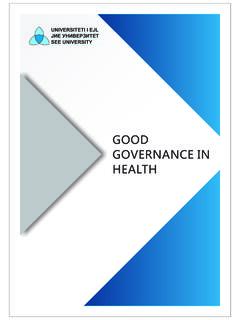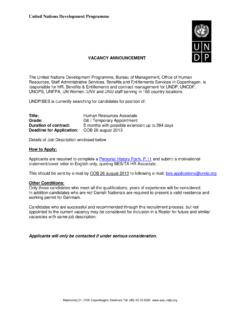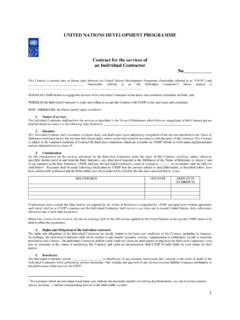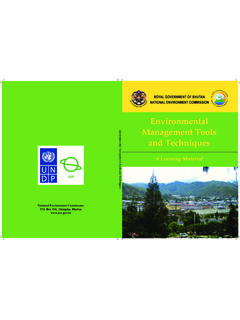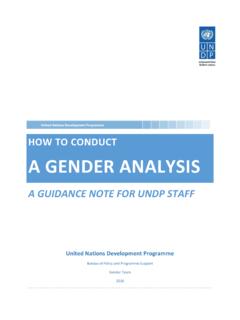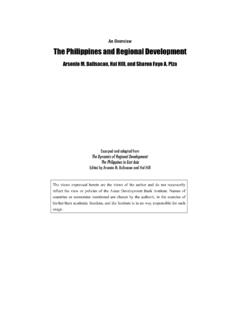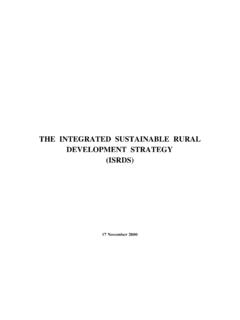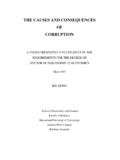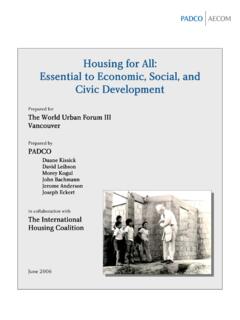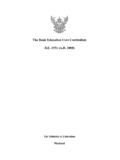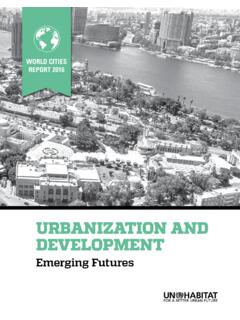Transcription of GOOD GOVERNANCE IN EDUCATION
1 GOOD GOVERNANCE IN EDUCATION1 GOOD GOVERNANCE IN EDUCATION Skopje, October 2010 2 Good GOVERNANCE in EDUCATION Case studies: Municipalities of Kisela Voda, Kriva Palanka, Vrapchishte, Bitola, Strumica, Shtip, Kicevo and Veles Skopje, October 2010 The SEEU expresses appreciation to the United Nations Development Programme (UNDP) and Oslo GOVERNANCE Center for the technical and financial support during the production of this report. 3 Authors: Marija Risteska, PhD Ana Mickovska Raleva, Mphill Mirjana Kraja - Sejdini, MSc Researchers: Nedzat Mehmedovic Erlin Agic Iga Grabowska Mirlinda Bakiu Tome Gushev Nadica Ljocheva Diogen Hadzi-Kosta Milevski Readers Group (in alphabetic order): Aferdita Haxhijaha-Imeri UNDP Social Inclusion Practice Coordinator Heather Henshaw Executive Advisor at SEEU Jadranka Sullivan UNDP Social Inclusion Specialist Loreta Georgieva Executive Director of Macedonian Centre for Civic EDUCATION Maja Gerovska Miteva Institute for Social and labour Policy Report Production Coordination: Shqipe Gerguri - SEEU Layout and Print: Arberia Design 4 Table of contents GOOD GOVERNANCE IN EDUCATION .
2 1 CASE STUDIES: MUNICIPALITIES OF KISELA VODA, KRIVA PALANKA, VRAPCHISHTE, BITOLA, STRUMICA, SHTIP, KICEVO AND VELES .. 2 BACKGROUND I. INTRODUCTION .. 5 THE RESEARCH PROBLEM, RESEARCH OBJECTIVES, RESEARCH QUESTIONS .. 10 RESEARCH METHOD, RESEARCH METHOD LIMITATIONS .. 11 RESEARCH SAMPLE .. 12 II. THE MACEDONIAN EDUCATION SYSTEM AND SOCIAL INCLUSION .. 13 EDUCATION IN MACEDONIA .. 13 SOCIAL INCLUSION AND EDUCATION .. 15 Children from different ethnic/language groups .. 15 Children living in distant rural areas .. 17 Female students .. 17 Children with special needs .. 19 Children from socially and economically deprived households .. 20 III. GOOD GOVERNANCE IN MACEDONIAN EDUCATION SYSTEM .. 21 1. LEGITIMACY AND VOICE .. 21 Citizen participation in educational policy making.
3 21 Citizen monitoring of educational services .. 23 Participatory budgeting .. 25 2. LEADERSHIP .. 27 3. PERFORMANCE .. 28 4. ACCOUNTABILITY .. 28 Horizontal accountability .. 29 EDUCATION performance rules and regulations .. 29 Management and inspectorates .. 31 Vertical accountability .. 32 The legislature .. 32 5. TRANSPARENCY .. 34 6. FAIRNESS .. 35 How EDUCATION GOVERNANCE affects social inclusion in Macedonia .. 43 Respect of the culture of non-majority communities .. 43 System of native language teaching .. 44 System of EDUCATION of children with special needs .. 46 Implementation of the social inclusion policies .. 48 System of detection and intervention in case of critical 50 IV. CONCLUSIONS AND RECOMMENDATIONS .. 51 5 Background Information Over the past 15 years, GOVERNANCE has become a key concept in the debates related to international development.
4 GOVERNANCE assessments vary according to the interests, needs and culture of the researchers. Some focus mostly on public sector corruption; others take a broader approach, which can include elements of human rights and democracy examined across civil society, the private sector, the judiciary and government institutions. Experience shows that emphasis to GOVERNANCE is crucial for health/ EDUCATION systems to fulfill their essential public health/ public EDUCATION functions. Both health and EDUCATION GOVERNANCE encompass institutions and linkages among citizens, government officials and health/ EDUCATION service providers. Ideally, good GOVERNANCE in health and EDUCATION should have the traits of responsiveness and accountability, transparency, encompass engagement of citizens and the capacity of state actors (central and local government decision makers) to design and implement policies in these sectors.
5 For that reason, for the past 18 months ( March 2009 September 2010) SEE University has teamed up with UNDP and has agreed to develop a nationally owned GOVERNANCE Assessment Methodology. ( ) This methodology should provide the tools for assessing the GOVERNANCE in health and EDUCATION sector with regard to social inclusion and poverty reduction. However, with minor adaptations, this methodology can be used as a foundation for GOVERNANCE assessment mapping in other sectors and provide much needed overview of GOVERNANCE issues and their impact on social inclusion. This methodology is developed to serve as a critical accountability mechanism to a variety of stakeholders, especially, the citizens of the Republic of Macedonia and non-state actors as well as to the decision makers to have the necessary information of improving the GOVERNANCE system and as such, substantially contribute to the GOVERNANCE reform processes initiated in the country.
6 Upon completion of the draft methodology, two research institutions were engaged to conduct GOVERNANCE assessment based on the Methodology on GOVERNANCE Assessment on social 6 inclusion policies in EDUCATION and health sector. Findings from the research will also be used as a tool for fine tuning the methodology itself. Once the methodology was agreed, the University embarked to pilot it in two selected sectors, in EDUCATION and health. Two research institutions were selected to organize and conduct the field research and analyze the gathered data. The EDUCATION report is produced by the Center for Research and Policy Making and features GOVERNANCE assessment of the EDUCATION sector in 8 municipalities. Both reports will be presented at a workshop and the comments and recommendations from the participants will be taken into consideration in the process of fine tuning the GA Methodology.
7 In late January 2011, 40 stakeholders from different ministries, public institutions and Civil Society Organizations will be trained on the final GA Methodology. The Final Assessment Methodology on GOVERNANCE issues and their impact on social inclusion in the EDUCATION and health sectors in the Republic of Macedonia is scheduled to be launched in March, 2011. 7 I. Introduction The concept of GOVERNANCE has received various definitions depending on authors and According to the Center for Good GOVERNANCE of Affiliated Network of Social Accountability - a joint venture between the World Bank and the Human Sciences Research Council - GOVERNANCE refers broadly to how power is exercised through a country s economic, social, and political institutions to use the country's resources for socio-economic development.
8 The process of GOVERNANCE encompasses the political, social and economic aspects of life, which have an impact on each individual, household, village, region or the nation. GOVERNANCE involves (1) the State, which is responsible for creating a political, legal and economic environment conducive for building individual capabilities and encouraging private initiative; (2) the civil society, which facilitates the mobilization of public opinion and people s participation in economic, social and political activities, and (3) the market, which is expected to create opportunities for people. GOVERNANCE includes therefore the sum of procedures, actions, and entities available to citizens (in order to enable them to conduct numerous operations, such as communicating their concerns, applying their rights, satisfying their duties, and arbitrating their disputes.)
9 The concept of good GOVERNANCE , initially introduced and applied by the World Bank in a 1989, is a convenient term that refers to the entire gamut of political and economic frameworks .2 Primarily, the good GOVERNANCE was identified as a structural necessity for market reform 3 In the course of time, the term has been largely validated within political science and theories of economic prudence, albeit under a different Although, GOVERNANCE as a term has progressed from obscurity to widespread usage, particularly in the last decade 5, it is still neither a homogenous nor a one-dimensional concept. Instead, it is a concept that acts like a receptacle in maintaining a growing number of mutually supportive goals and processes.
10 6 1 For further study, see for example: Demmers, Jolle, Jilberto, A. E. Fernandez and Hogenboom, Barbara (eds.): Good GOVERNANCE in the Era of Global Neoliberalism: Conflict and Depolitisation in Latin America, Eastern Europe, Asia and Africa, New York: Routledge, 2004; Gerring, J.: A Centripetal Theory of Democratic GOVERNANCE , Cambridge, Boston University, 2008 2 Chowdhury, N. and Skarstedt: The Principle of Good GOVERNANCE . Draft Working Paper in, Recent Developments in International Law Related to Sustainable Development, 2005:11 3 Chowdhury, N. and Skarstedt , , 2005, 4 Chowdhury, N. and Skarstedt , , 2005, 5 Graham, J., B. Amos and T. Plumtre: Principles for Good GOVERNANCE in the 21st Century in, Policy Brief, , 2003:1 6 Chowdhury, N.

